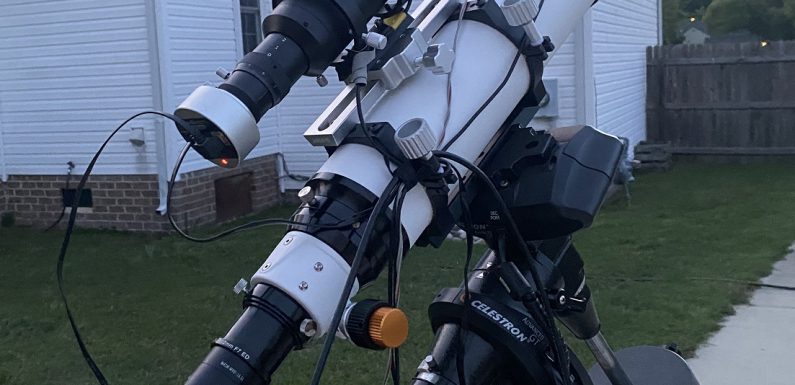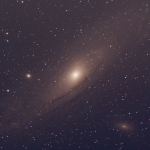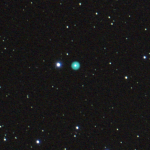
I volunteered to create the September 2022 EAA Monthly Observing Challenge list for the CloudyNight’s EAA Forum. Each month a member of the forum creates a list of objects to be observed via Electronic Assisted Astronomy (EAA). The monthly EAA challenge list is a great program and I have observed a lot of interesting objects which I probably would not have observed otherwise if it was not for the challenge lists.
This is my first time creating a list like this. To create the list I set the date and time in KStars to the the middle of September in the middle of the night and browsed around for some interesting targets. I ended up with a list of about 15-20 targets but narrowed it down to 8 (well 9 if you count the 2 open clusters in the Double Cluster).
I think most of these targets should be obtainable with modest gear. Some of these objects I have observed before, either visually or via EAA, others will be new targets for me as well. Here is the list I came up with for the September 2022 Monthly EAA Observing Challenge…
- M 39 – Open Cluster in Cygnus – This one should be pretty easy. M39 is a nice open cluster of about two dozen blue and yellow stars. Even though there are some other great Messier objects in the September night sky M 39 is the only Messier object on this month’s list.
https://en.wikipedia.org/wiki/Messier_39 - NGC 6960 – A supernova remnant in Cygnus – The Western Veil Nebula also known as the Witch’s Broom. Wispy stringy blue, green, and red nebula which are the remains of an exploding star. NGC 6960 is just a small part of the Veil Nebula. An O-III filter may help here, but I have observed it many times without one.
https://en.wikipedia.org/wiki/Veil_Nebula - NGC 457 – Open star cluster in Cassiopeia – The Owl Cluster – This is one of my favorites! This cluster contains about 60 stars. Lot of nice color in this cluster with blue, white, and a few yellow stars. The brightest stars are the two which make up the owl’s eyes.
https://en.wikipedia.org/wiki/NGC_457 - NGC 884 and NGC 869 – The Double Cluster located in Perseus – This is a favorite of mine to observe visually, don’t think I have ever EAA observed it but since I added it to this list I plan to give it a try. Each cluster contains more than 300 blue-white giant stars.
https://en.wikipedia.org/wiki/NGC_884 and https://en.wikipedia.org/wiki/NGC_869
https://en.wikipedia.org/wiki/Double_Cluster - NGC 7380 – Open cluster in Cepheus – The open cluster of stars is surrounded by an emission nebula known as the Wizard Nebula. Might need an O-III filter for the nebula in this one.
https://en.wikipedia.org/wiki/NGC_7380 - NGC 7331 – An unbarred spiral galaxy in Pegasus – Has a lot of friends including NGC 7335, NGC 7336 and several others which you may also be able to resolve. NGC 7331 is the brightest galaxy in what is known as the Deer Lick Group.
https://en.wikipedia.org/wiki/NGC_7331
https://en.wikipedia.org/wiki/NGC_7331_Group - Stephan’s Quintet – A galaxy group in Pegasus – NG7320, NGC 7319, NGC 7318a and 7318b, NGC 7317 – This group of galaxies was the inspiration for the angels at the beginning of the 1946 holiday film “It’s a Wonderful Life”. Recently made famous as one of the first publicly released images from the James Webb Space Telescope. Give it a try and see what you can get without spending $11 Billion Dollars.
https://en.wikipedia.org/wiki/Stephan’s_Quintet - IC 10 – A starburst galaxy in Cassiopeia – I have not observed this one before, I was browsing the area around Cassiopeia in KStars to try to find something interesting for this list and here it is. This is probably going to be the most difficult on this month’s list. I am looking forward to giving it a try and also looking forward to seeing what others are able to capture.
https://en.wikipedia.org/wiki/IC_10
Not EAA objects and not part of the list but just wanted to make note that Saturn, Neptune, Jupiter, Uranus, and Mars will all be visible at some point in the September night sky (all of them should be up at the same time in the middle of the month), so if you are into the planets there will be a lot to see. I might try to capture Neptune and Uranus using EAA, the others are likely too bright.
The forum post for the September 2022 EAA Observing Challenge is here for you to post your EAA captures of objects on the list. Looking forward to some clear skies so I can run though the list myself.
Check out the previous EAA monthly challenges to discover some targets which be something new to see.
Enjoy the list… clear skies and happy hunting.








